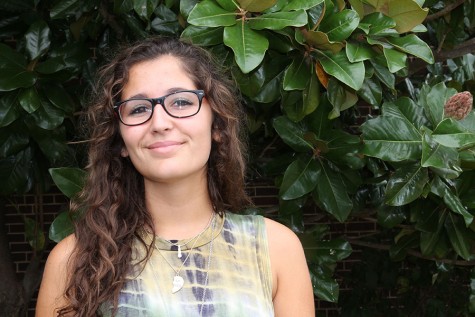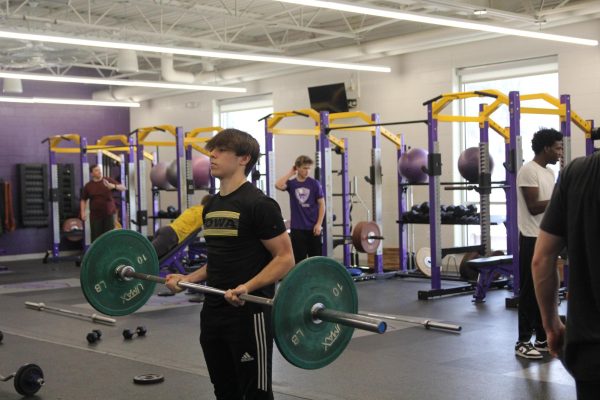Living in color
Project Semicolon is a non-profit organization that hopes to achieve lower suicide rates in the U.S. and around the world. A semicolon symbolizes a sentence that could have ended but didn’t, similar to suicide prevention. Cameron Nisbet (12), supporting Project Semicolon, Oct. 19. “It gets better,” Nisbet said.
A world full of color and pizzazz fades into a gray emptiness. Disney Pixar’s Inside Out illustrates the dark turn a happy and full life can take.
For those who haven’t struggled with depression or another mental health issue, understanding the level of hopelessness that accompanies such a clinical disorder can not only change a person’s own life but also the lives of those around them.
Suicide is the third leading cause of death in youths in the United States, according to the National Alliance on Mental Illness.
The month of September was Suicide Prevention Awareness Month. The point of it is to inspire people who are depressed to reach out for help and for people who don’t have depression to spread awareness in order to get troubled people the support they need, according to NAMI.
“A cause of suicide is probably high school and adolescence,” Michelle Thai (12) said. “Everyone’s just really stressed out about life, and you’re pressured a lot by everyone around you. You have your peers pressuring you to be a certain person, and your parents want you to be a certain person. It’s easy to get overwhelmed.”
High school forces teenagers to go through many changes, as well as self-discovery, which can trigger intense emotions.
With so many activities and clubs, the options are endless, and discovering limitations can be challenging for both parents and students.
“Parenting has kind of changed,” Kristy Raymond, counselor, said. “I see it in myself as a parent. Parents just get their kids involved in lots of things at a young age and want them to be successful in what they do. I don’t think they purposefully push their children, but they subconsciously push their kids and don’t let them have time just to be.”
The pressures that teenagers face can contribute to their feelings of being overwhelmed. Prolonged stress is a proven risk factor for depression and suicide among people.
Unfortunately, the world doesn’t turn black and white when a loved one struggles with losing a sense of purpose. Rarely do suicidal thoughts manifest outwardly as crying and gloom.
Even parents can have a difficult time realizing if their child has a mental health condition because of the tendency to mask it.
“Sometimes people hide their depression,” Naomi Warren, EHS social worker, said. “Depression is really scary. It’s also, unfortunately, still stigmatized. As common as it is and as increasingly common as it is, a lot of times when people experience depression, people feel very alone and may feel that no one else can understand what they are going through. They feel like it’s not something that they can or should talk about.”
Because people keep their feelings all bottled up, warning signs can be difficult to notice.
Ninety percent of people who commit suicide have an underlying mental condition like depression, but when they are depressed is hard to pinpoint, according to NAMI.
“If people are depressed, they’ll feel really, really lonely or unhappy but won’t always show it,” Dalton Roller (9) said. “If you see somebody being bullied, you should tell someone immediately, especially if the person being bullied doesn’t.”
One in four kids are bullied on a regular basis, and bullying, the repetitive, taunting behavior to a certain target, is highly linked to depression and suicide in youths.
Untreated depression is the number one cause of suicide. When people do not communicate that something is wrong, help cannot be given to them, and thoughts of suicide may kick in.
Throughout their careers, educators witness the toll these secret burdens take on teenagers and their families.
“It is an act of despair,” Mr. Crouther, interim principal, said. “They feel hopeless. They feel there is no one to turn to, no one to talk to. But if they thought back and gave it some consideration, there are probably many, many, many people who love them deeply. The two young men that I know who committed suicide had family and friends that would have done anything they could have to talk them out of it and help in any shape, fashion or form to prevent it.”
Anyone in the community can contribute to suicide prevention.
“Suicide is preventable,” Ms. Warren said. “It is something that requires a lot of awareness and a lot of support. But, yes, ultimately it is something that can and should be addressed. There are a number of ways that individuals can be helpful. Having on our minds that suicide is something to look out for and not be scared to talk about is one way. Just being a caring, compassionate listener is a way individuals can prevent suicide and knowing when to pass that person along to someone who can be more helpful.”
Some resources offered by the EHS counselors are MO ALR Suicide Prevention Training Program and Kids Under Twenty One, which lets young people contemplating suicide talk to other trained young people who offer support and positive alternatives to suicide, according to Ms. Warren.
“We can prevent suicide,” Britt Dubose (12) said. “If a person is having problems or stressed out, we could help them by talking to them about it.”
Depression is not a state of mind that can be talked away with a friend. Finding the right professional, like a counselor or doctor, is essential for treatment.
“There are five outstanding counselors,” Mr. Crouther said. “Every one of them is well trained in this, and they can work with it, deal with it and call in for assistance. If there is someone here who is thinking about it, I would highly suggest talking to them.”
While talking to peers is a first step, a caring adult can be the difference between life and death.
“I think that they feel more comfortable talking to their peers, whether it’s through social media or just verbally talking to their peers,” Mrs. Raymond said. “Nine times out of 10 we don’t have kids come in here, but sometimes we get reports from outside sources that a kid is feeling suicidal.”
The counselors are trained to do a life pact, an assessment of specific questions to find out what level they are thinking about suicide. They do not diagnose whether a student has depression or anxiety. After questioning, they immediately contact parents and provide them with sources, such as doctors and psychiatrists, to help.
The counselors tell parents because that is the only way to have access to medical insurance to get the help they may need and to hopefully encourage a supportive home environment.
“I would love for kids to reach out and get help,” Mrs. Raymond said. “I also encourage friends to listen to each other and pick up on signs and report anything that is suspicious. What they’re feeling is very strong in the moment, but it can only be temporary.”
Although the world around a person with a mental disorder may be empty and without joy, stained gray and blue, joy can and will return along with an array of colors, life and purpose.
“People contemplating suicide can feel the way they were feeling maybe a year ago or six months ago,” Mrs. Raymond said. “That is possible. We can figure out a solution and work through it.”
Your donation will support the student journalists of Eureka High School - MO. Your contribution will allow us to purchase equipment and cover our annual website hosting costs.

This is Lauren's second year on staff. You can follow her on twitter @lroccaEHS_hub. Her hobbies include Golden Line. Outside of school she is involved...

This is Mary Kay's second year on staff. You can follow her on twitter @mkgagEHS_hub. Her hobbies include hanging out with friends, and collecting unique...





















